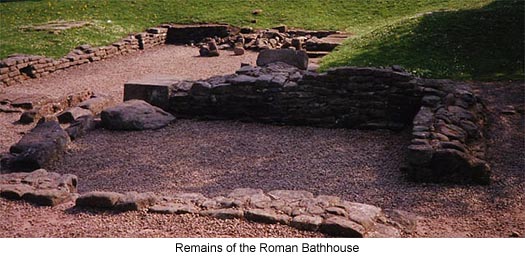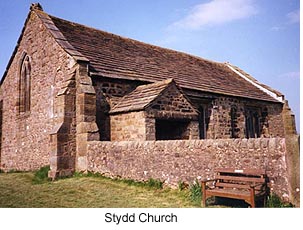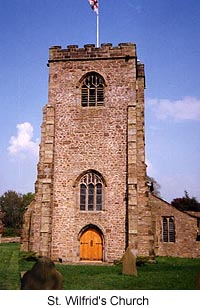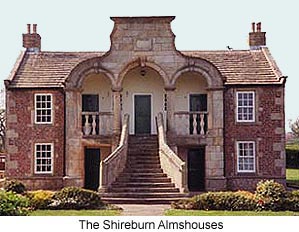The Roman Riches of Ribchester
by Elizabeth Ashworth
"It is written on a wall in Rome that Ribchester was as rich as any town in Christendom." This is an ancient saying whose origins have been lost in time but may refer to a rough translation of the Latin inscribed on some artefact long since discovered and lost again.
The Roman settlement that was built in Ribchester, East Lancashire was called Bremetennacum Veteranorum, the hilltop settlement of the veterans, and dated from about AD 78 in the reign of the Emperor Vespasian when Britain was under the governorship of Julius Agricola. The fort was originally built of timber and turf on a site of five and three quarter acres, but was rebuilt of stone in around AD 100. The occupation here lasted for over three hundred years until the fourth century and the soldiers were mostly cavalry, including Asturians from Spain and Sarmartians from what is now Hungary. The suffix Veteranorum indicates that veterans, those retired from active service, were also settled here. They were granted the use of land lying close to the fort to grow crops and to raise cattle and horses, and may have been involved in the breeding and training of horses for the cavalry.
The site of the fort is approximately where the church and churchyard now stand, although part of it is under the River Ribble as the flow of the river has altered over the years. Besides the fort there was also a Romano British village, or Vicus, here where the civilians lived and the remains of this lie under the modern village.
 Many artefacts have been found both in the gardens of local houses and in the River Ribble. The famous 'Ribchester Hoard' was discovered in 1796 by a boy of thirteen, John Walton, who lived with his family in a house near the river. Whilst digging in the garden he unearthed a collection of items, the most important of which was a bronze cavalry parade helmet. The original helmet is now in the British Museum, but the Roman Museum in Ribchester has a replica. This museum was originally opened in 1914 by Margaret Greenall to prevent the loss from the village of the many Roman artefacts found there. It was originally just one room, housed in a small building by the churchyard. Over the years the museum has been improved and extended and re-opened in 2002 following an extensive refurbishment. Now Roman Ribchester is brought to life in a series of displays with many interesting finds, including coins and everyday items such as combs, brooches and other jewellery, cooking pots and jars. There are also remnants of leatherwork, once used to harness horses, and examples of inscribed memorial stones and an impressive sculpture of a cavalryman riding down his Celtic adversary. The museum is open all year round: Mon to Fri 9:00 - 17:00, Sat-Sun 11:00 - 17:00.
Many artefacts have been found both in the gardens of local houses and in the River Ribble. The famous 'Ribchester Hoard' was discovered in 1796 by a boy of thirteen, John Walton, who lived with his family in a house near the river. Whilst digging in the garden he unearthed a collection of items, the most important of which was a bronze cavalry parade helmet. The original helmet is now in the British Museum, but the Roman Museum in Ribchester has a replica. This museum was originally opened in 1914 by Margaret Greenall to prevent the loss from the village of the many Roman artefacts found there. It was originally just one room, housed in a small building by the churchyard. Over the years the museum has been improved and extended and re-opened in 2002 following an extensive refurbishment. Now Roman Ribchester is brought to life in a series of displays with many interesting finds, including coins and everyday items such as combs, brooches and other jewellery, cooking pots and jars. There are also remnants of leatherwork, once used to harness horses, and examples of inscribed memorial stones and an impressive sculpture of a cavalryman riding down his Celtic adversary. The museum is open all year round: Mon to Fri 9:00 - 17:00, Sat-Sun 11:00 - 17:00.
There was also a temple built near the fort and the stone pillars outside the White Bull Hotel are thought to have originally been a part of this. They were found in the river over two hundred years ago.
 The Roman bath-house was first discovered in 1837. Built to the north west of the fort and just outside its walls, the remains were uncovered in the garden of the village doctor, Dr Patchett. But many of the stones, pillars and tiles were taken away to be used in other buildings and it wasn't until between 1963 and 1967 that the site was properly excavated. Now it is now preserved for the public and administered by Lancashire County Council. The site is open from Easter until the end of October and admission is free of charge.
The Roman bath-house was first discovered in 1837. Built to the north west of the fort and just outside its walls, the remains were uncovered in the garden of the village doctor, Dr Patchett. But many of the stones, pillars and tiles were taken away to be used in other buildings and it wasn't until between 1963 and 1967 that the site was properly excavated. Now it is now preserved for the public and administered by Lancashire County Council. The site is open from Easter until the end of October and admission is free of charge.
Also open to visitors are the external remains of the Roman granaries that have recently been made more accessible with the laying of a new path. A section of the northwest rampart and defensive ditch can also be seen along the footpath leading to the public car park.
Legio Secvnda Avgvsta, the Roman Living History Society, visit Ribchester each year for a re-enactment of the occupation and will be there over the weekend 9-10th July 2005.
The Romans left Ribchester at the end of the fourth century, and those inhabitants that were left probably made a living by farming until the village was destroyed during raids by the Scots under Robert the Bruce.
 It was later rebuilt by the Normans and the parish church of St Wilfrid, built on the site of the Roman fort dates from this period, with written evidence recording a date of 1193 for the establishment of a church on this site. But as it is traditionally thought that all the churches dedicated to St Wilfrid were founded by the saint himself, there could have been a church here as long ago as the seventh century. St Wilfrid's is a beautiful and atmospheric church and is usually open to visitors. Take some time to look at the gravestones in the churchyard too. The ones that record the deaths of as many as four children from the same family make harrowing reading and remind us that this picturesque place was not always so idyllic as we might think. Diseases such as typhoid fever, caused mainly by a lack of clean drinking water, claimed many lives up until the early twentieth century.
It was later rebuilt by the Normans and the parish church of St Wilfrid, built on the site of the Roman fort dates from this period, with written evidence recording a date of 1193 for the establishment of a church on this site. But as it is traditionally thought that all the churches dedicated to St Wilfrid were founded by the saint himself, there could have been a church here as long ago as the seventh century. St Wilfrid's is a beautiful and atmospheric church and is usually open to visitors. Take some time to look at the gravestones in the churchyard too. The ones that record the deaths of as many as four children from the same family make harrowing reading and remind us that this picturesque place was not always so idyllic as we might think. Diseases such as typhoid fever, caused mainly by a lack of clean drinking water, claimed many lives up until the early twentieth century.
Just outside the village, a short walk up a pleasant country lane is the old church of St Saviour's, better known as Stydd Church. It is the surviving chapel of a Christian settlement built here in the twelfth century by the Knights Hospitallers of St. John of Jerusalem. The church is usually open to visitors on summer weekends and there are occasional services and weddings held here.
On the way to the church look out for the almshouses on your left. They were built by John Shireburn in 1726 to accommodate 'five old and infirm women professing the Catholic faith'. They have been renovated over the years: in 1962 to provide kitchens, bathrooms and running water and again in 1990, but they have remained unspoiled. Also along this lane is the Roman Catholic church of St Peter and St Paul. It was built in 1789 when it was illegal for Roman Catholics to have public places of worship and was constructed to look like a barn. Originally much smaller, it was extended in 1877 and now could not be mistaken for anything but a church.
 Like so many Lancashire villages, the inhabitants of Ribchester over the years made a living not only by farming but through the production of textiles. Many of the stone terraced cottages were built for handloom weavers and even small Lancashire villages did not escape the industrial boom years and Ribchester had two mills. Ribblesdale Mill was built in 1863 and at its peak ran 684 weaving looms. It closed in 1973 and was demolished in 1990. A small housing estate was built on the site and named Sarmatian Fold in honour of the Roman horsemen stationed here so long ago. Bee Mill, named after Beatrice Openshaw who performed an opening ceremony by smashing a bottle of champagne over the flywheel was built in 1888 and is still in existence today, divided into a series of industrial units housing small specialist businesses.
Like so many Lancashire villages, the inhabitants of Ribchester over the years made a living not only by farming but through the production of textiles. Many of the stone terraced cottages were built for handloom weavers and even small Lancashire villages did not escape the industrial boom years and Ribchester had two mills. Ribblesdale Mill was built in 1863 and at its peak ran 684 weaving looms. It closed in 1973 and was demolished in 1990. A small housing estate was built on the site and named Sarmatian Fold in honour of the Roman horsemen stationed here so long ago. Bee Mill, named after Beatrice Openshaw who performed an opening ceremony by smashing a bottle of champagne over the flywheel was built in 1888 and is still in existence today, divided into a series of industrial units housing small specialist businesses.
The rest of the village is mainly residential with a few small shops, although there are several hotels and cafes serving the needs of visitors and you can easily find anything from cups of tea and ice creams through to quality meals. There is also a superb children's playground adjacent to the free car park (with free public toilets), based on the theme of the Roman fort. And for a quieter moment you can simply sit on the grassy bank of the River Ribble and contemplate all the peoples who have sat on the same spot before you over hundreds of years.
More Information:
We regret that we no longer have the resources to maintain up-to-date links and/or hours and pricing details for the various sites and attractions listed on this website. For more information about the location(s) listed above, please use your favorite search engine or visit Wikipedia.
Elizabeth Ashworth writes fiction and nonfiction for both adults and children. Her short stories have appeared in such publications as Christian Herald, People's Friend, Take a Break Fiction Feast, My Weekly and Parentcare; her nonfiction has appeared in a variety of magazines, including The Lady, Lancashire Life and My Weekly. She is also a regular contributor to Lancashire Magazine. Her books include Champion Lancastrians (Sigma Press, 2006) and Tales of Old Lancashire (Countryside Books, 2007); she is currently working on a book on Lancashire Graves, and a novel titled "The De Lacy Inheritance."
Article and photos © 2005 Elizabeth Ashworth
|
